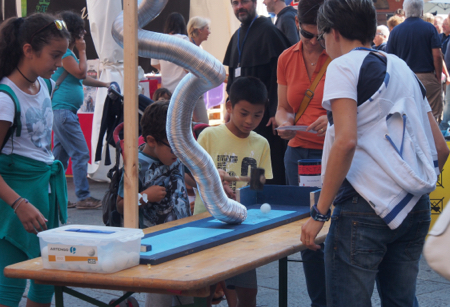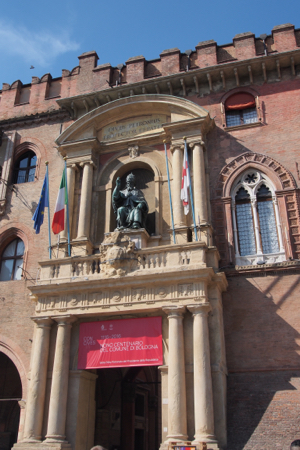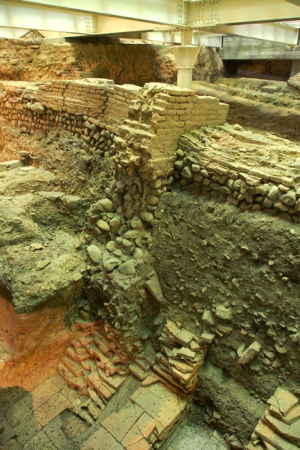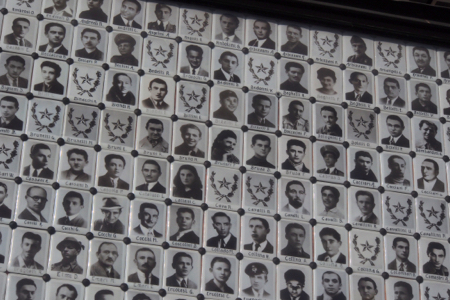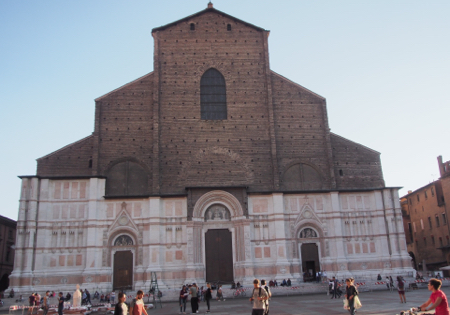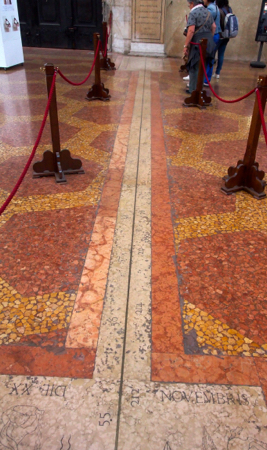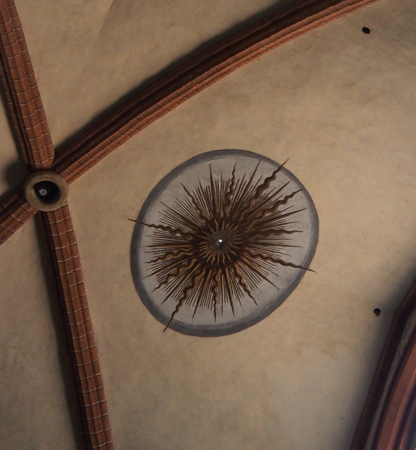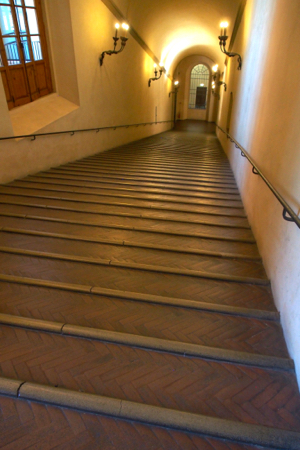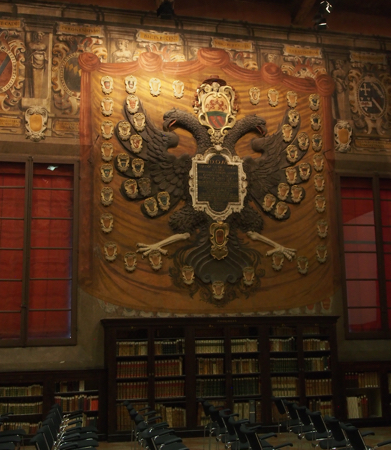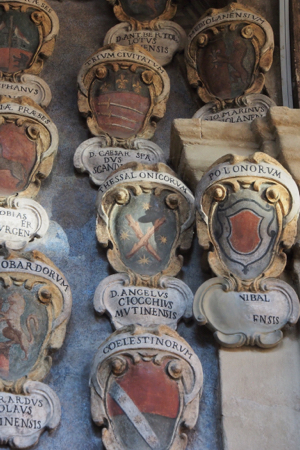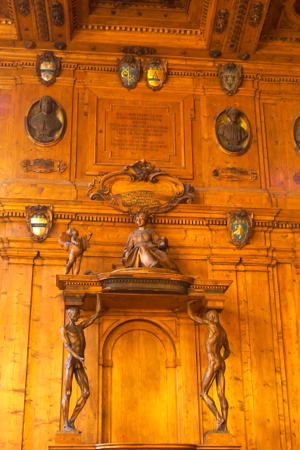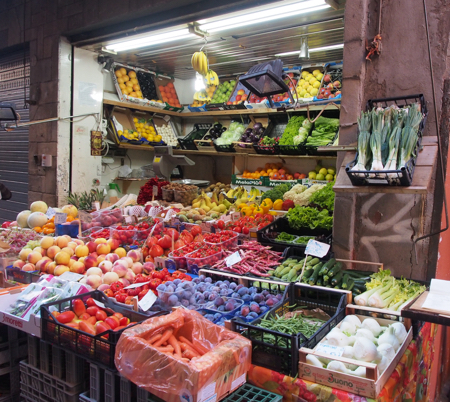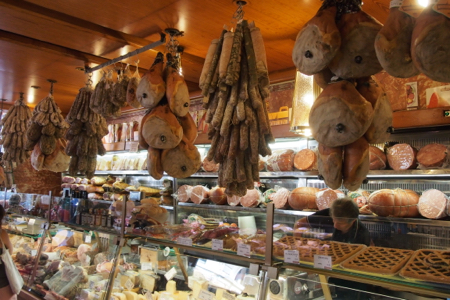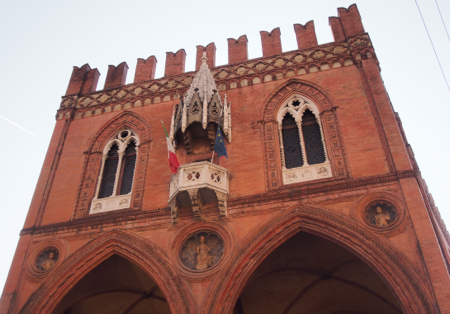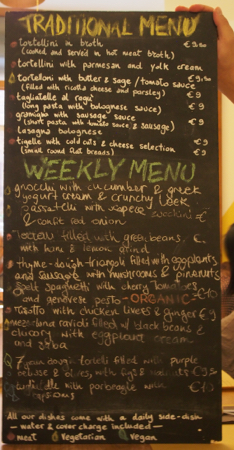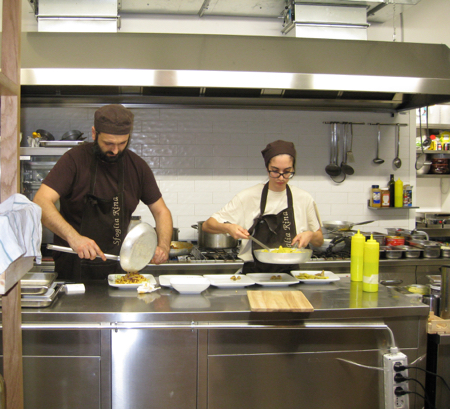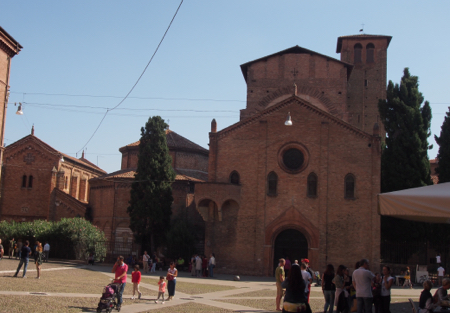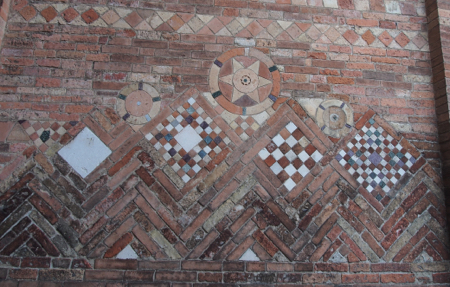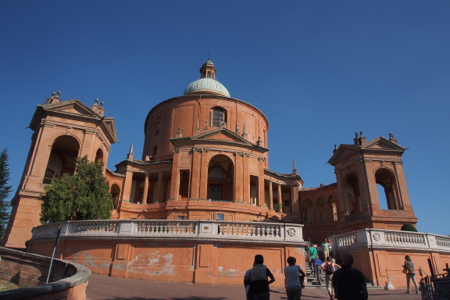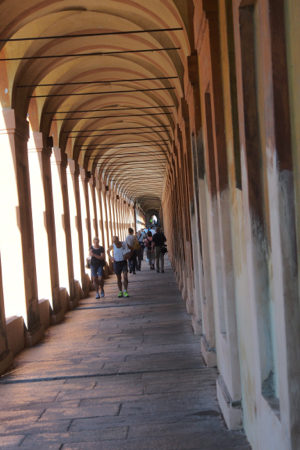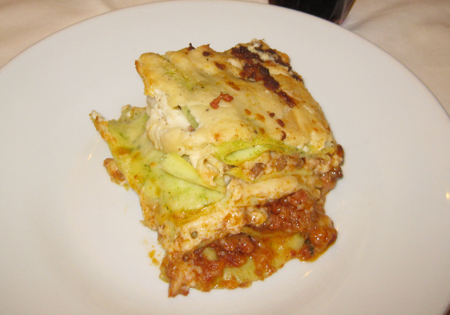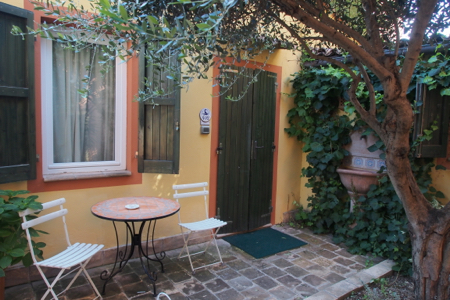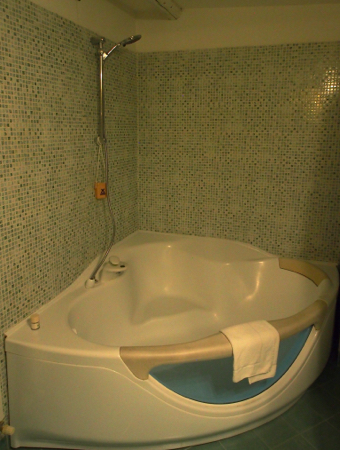Sat., 9/24/16 and Sun., 9/25/16 – Bologna
Saturday was a day of leisure after our excursions of the previous two days. Also, we had to move from the Zanhotel Europa to the other end of town to the Hotel Porta San Mamolo where our OAT tour was staying. This we did in the morning and met our tour director, Tommaso. Later, he took us, and other early arrivals, on a walking tour into the center of town. On Sunday, a local guide took us on a city tour as well so the information, photos, and descriptions of both of these events are combined below.
There was a Franciscan Festival in the Piazza Maggiore, so the center of town was buzzing with people both days we were there. Our local guide began her presentation by describing Bologna using the words: Red, Education, and Fat. Red because most of the buildings are of terra cotta brick; it has the oldest (maybe) university (from 1088) for medicine and law; and fat because of all the pasta that people eat. Supposedly lasagna was invented here. Bologna also has more than 20 miles of porticos.
Porticos of Bologna
Franciscan Festival in the Piazza Maggiore
Kids playing a game at the Festival
Facade of the Palazzo d’Accursio, the former City Hall
Our tour took us inside the library, the Sala Borsa, to see the Roman ruins under the building. As happens many times in Europe, when constructing the foundations of a new building ancient ruins are discovered. These were left in place in this case and were opened to the public only recently. We walked along a grated catwalk and looked at 1st c. Roman road and foundations of the forum below medieval fill and brick foundations.
On the outside wall of the Sala Borsa is the Wall of Memory commemorating the men and women in the Italian resistance who died in WWII.
Roman ruins under the Sala Borsa Library
Sala Borsa
Wall of Memory - Photos of WWII Italian Resistance fighters
Sala Borsa
Wall of Memory - Photos of WWII Italian Resistance fighters
The Basilica of San Petronio is very plain with high arched ceilings and some side chapels. There is no transept. The most interesting feature was the meridian line (Cassini's Meridian Line) angled down the left side. At either end of the line are marked 21 December and 21 June, with other important dates indicated at appropriate locations in between. The midday sun, shining through a small hole (or oculus) in the ceiling, makes a bright circle that moves across the lines marking the date. In the Middle Ages this allowed the church to celebrate specific rites on the correct day. The zodiac signs are also carved into the line.
Basilica of San Petronio
Meridian Line in the Basilica of San Petronio
“Eye” for sun to shine through to the Meridian Line
Meridian Line - Current location of sun
We briefly visited the City Hall that was originally (1200’s) the home of a professor and his students. In 1300 his family sold it to the city. In the 1500’s it was renovated and the “Big Room” on the second floor had frescos painted on the walls and in the large meeting rooms on both sides. The “stairs” are sloped because princes or nobility used to enter on horseback in order to impress the populace. We walked down the horse ramp to the first floor.
On the way to our next stop, we walked through a Roman arch where a whisper in one corner can be heard clearly in the opposite corner.
Our tour next went to the ancient university building of anatomy and law. We sat in the room where Rossini first performed his “Stabat Mater” - the room is named for that piece of music. The library has 800,000 old books.
On the hallway walls and ceilings are coats-of-arms. Each anatomy class of 50 students elected one representative student whose name and country are painted on his coat-of-arms on the wall. Students from around the world attended here – from America (probably South America), England, Poland, India, etc. Then we entered the ancient anatomy theater. The professor sat high up at one end and the students on elevated benches around the sides. A marble table was in the middle and an assistant would perform dissections at the professor’s instruction. The ”goddess” of anatomy and a cherub sat above the professor and Apollo, the protector of doctors is opposite.
Inside the City Hall - Staircase for horses
Gale in the “Whisper” corner
Stabat Mater room in the Archiginnasio Municipal Library
Coats-of-arms of graduated medical students in the Archiginnasio building
University of Bologna
Anatomical Theatre of the Archiginnasio
Anatomical Theatre of the Archiginnasio
Anatomical Theatre of the Archiginnasio
On the way to lunch we walked into the market alleys, an area crammed with people. Bars and cafes had tables and chairs filled with people eating or sipping coffees. Shops sold all kinds of hams and cheeses and vegetables.
Cheese store
Market
Meat and cheese market
Building with Ghibelline tower merlons - erected by those loyal to the Holy Roman Emperor instead of the Pope
Lunch was at Sfoglia Rina. We shared a lasagna and tortellini in broth. Tortellini are small (belly buttons) filled with meat and tortelloni are large and filled with cheese.
Menu at Sfoglia Rina
Kitchen at Sfoglia Rina
Lunch
After lunch, Tommaso took us to the “Seven Churches.” (There are now only four.) The churches were built in the 6th to 8th c. to reflect Jerusalem: the Church of Crucifixion or St. Steven’s; Holy Sepulcher reconstructed from Crusaders’ drawings; the Church of Two Martyrs; and Trinity Church. In the middle is the Courtyard of Pilate with a large Baptismal Font and a statue of a rooster.
Church of the Crucifix
Wall in the Courtyard of Pilate
Remains of ancient canals
We had a little free time we so went to find the Cremeria Funivia to get a gelato. Tommaso said this was the best place in Italy for gelato. We definitely agreed! We had pistachio or amaretto with chocolate – yummy! Then we hustled back to the Piazza to take the little “train” up to the Church of St. Luke.
The train struggled up the hill and deposited us at the top. We entered the church and walked around to the decorative apse. The train was not very comfortable so we decided to walk the 2 ½ miles back down to the hotel. The first two miles was under the Portico di San Luca, part very steep with many steps and then flat. It took us just about 1 hour and 12 minutes.
Our Welcome Dinne rwas at Trattoria Osteria Buca Manzoni. We all ate too much! Roasted/grilled vegetables and bread, lasagna, veal with prosciutto and Parmesan sauce, and then dessert - and lots of wine, of course.
"Train" to the Church of St. Luke
Church of St. Luke
Church of St. Luke
Portico di San Luca leading to/from the Church of St. Luke
Lasagna at our Welcome Dinner
Entrance to our "suite" at the Hotel Porta San Mamolo
Our no shower curtain, stand on the step, "shower"
| Return to Top | Return to Itinerary | Return to Trips page to view other trips | Return to Dreamcatcher Home Page |


